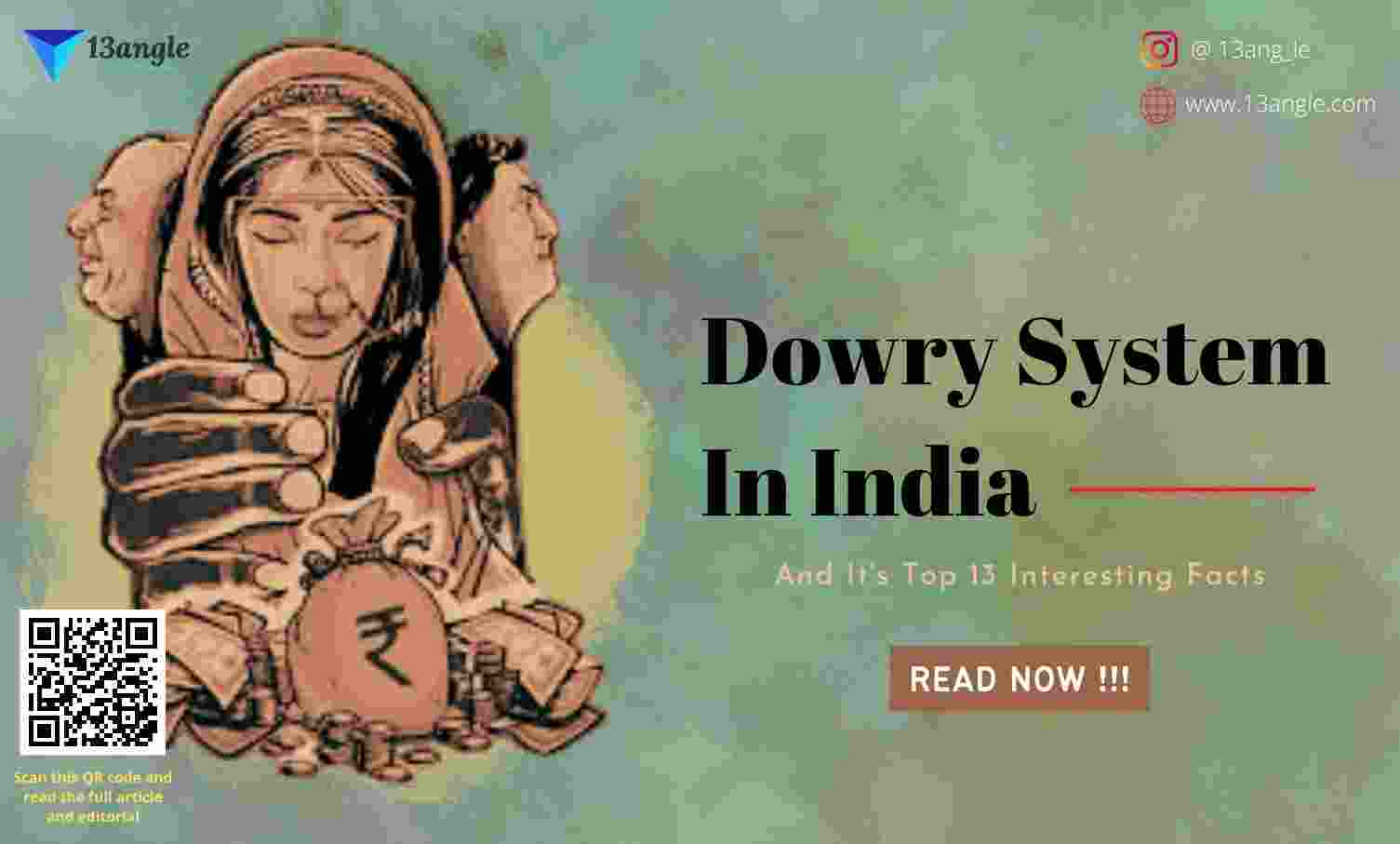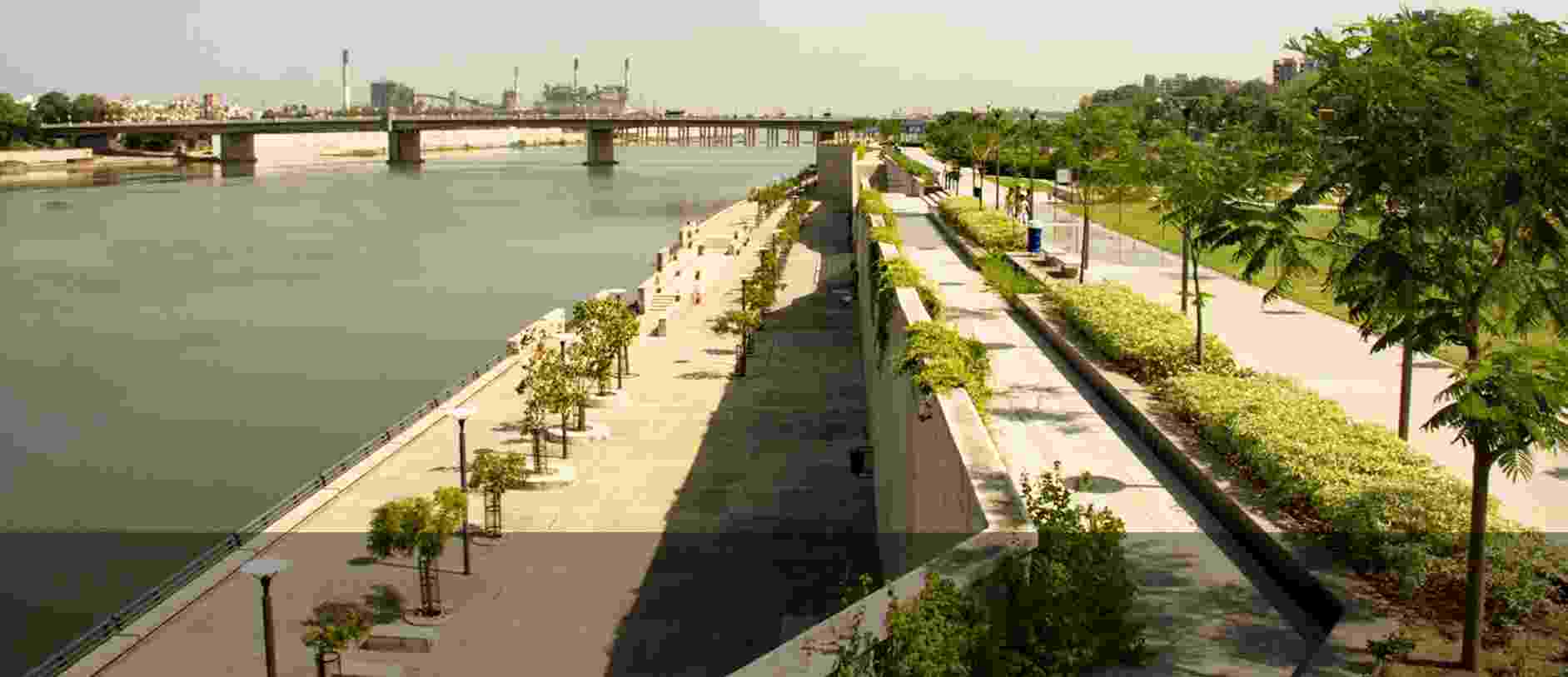
Introduction
- Narendra Modi looms over visitors to Ahmedabad, the main city of Gujarat, at almost every turn. The big-brother omnipresence of India’s prime minister is part of the build-up to a big trade fair held in neighboring Gandhinagar, a showcase for the business-friendly state initiated in 2003 by Mr. Modi when he was its chief minister.
Vibrant Gujarat Summit
- The 2015 Vibrant Gujarat summit, the seventh such event, will run for three days from January 11th, when Mr. Modi will make a speaking appearance. It will be a vast affair with visitors from 125 countries. A fleet of golf buggies, with plastic wrap still on the seats, stands ready to ferry visiting dignitaries, including John Kerry, America’s secretary of state, between the hangar-sized exhibition halls.
Gujarat Growth
- Gujarat is richer and enjoys faster GDP growth and a greater intensity of jobs and industry than India as a whole. Mr. Modi’s reputation for clean government and economic competence rests on his record here. When Indians voted for him in great numbers last May, it was in large part because they wanted the country run as Gujarat is. His impact on the state is nevertheless contested. It is helpful, say Mr. Modi’s critics, that he built a platform for a career in national politics in a state that already had deep roots in commerce (the Mafatlal textile plant, an hour’s drive south of Ahmedabad, for instance, recently celebrated its centenary). What is clearer is that Mr. Modi’s time in Gujarat offers a guide to his approach to the bigger job of fixing India’s economy. Gujarat’s development journey has received tremendous praise both across India and the world.
Development Oriented Governance
- Under Narendra Modi’s leadership, Gujarat was known for its development-oriented governance where the people were made active partners and stakeholders in the development journey. When Narendra Modi took over as the Chief Minister Gujarat was reeling under the effects of a devastating Earthquake. The drought, cyclones, and floods in the preceding years too slowed the development journey. Everyone thought the damage in Gujarat would take years to be undone but Narendra Modi and his team proved everyone wrong by putting Gujarat on the path to recovery and development in a record time of under three years.
World Comment On Gujarat Development Model
The entire world talks about the Gujarat Model of Development. This is a Model that celebrates the collective efforts of the people of Gujarat. Gujarat’s development journey is characterized as development-oriented, inclusive, and participative. Decisions were not taken behind closed doors by select individuals but were taken after consulting all the stakeholders. Optimum use of technology was made to minimize corruption and increase the pace of development.
Another special facet of the development of Gujarat is that it is not centered around any one sector. All three sectors namely agriculture, industries, and services made an equal and active contribution to the growth of Gujarat.
Development In The Agriculture Sector
Under Narendra Modi, the farmers of Gujarat witnessed unprecedented prosperity. The annual Krishi Mahotsav brought several services and opportunities to the doorstep of the farmers. The farmers received Soil Health Cards that gave them much-needed guidance on enhancing their productivity. Special attention was also devoted to animal husbandry.
Industrial development scaled new heights in Gujarat in 2001. In 2003 the biennial Vibrant Gujarat Summits began that drew record investment to the state. At the same time, the land acquisition policy put in place by the Government ensures no injustice is done to the people where the industry is coming up.
Narendra Modi devoted special attention to the healthcare and education sector. Since 2004 the Shala Praveshotsav and Kanya Kelavani Drive are undertaken by every Government official including the Chief Minister went to the villages of Gujarat asking parents to send their children to school. This has received phenomenal results as the school dropout ratios have dropped considerably since Narendra Modi took office.
Governance in Gujarat has reached the very last person in the queue. Due to the Garib Kalyan Melas, the fruits of development reach the intended beneficiaries without any middlemen. In 2008 the Gujarat Government launched the Vanbandhu Kalyan Yojana, a special package devoted to the development of the tribal communities. Today the package is worth Rs. 40,000 crores and has brought smiles to the faces of several people across Gujarat.
A firm believer in youth-led development, Narendra Modi devoted a lot of efforts toward enhancing skill development among the youth. From building more ITIs, upgrading syllabus and infrastructure in the ITIs to integrating skill development programs with technology, a record number of steps have been taken for skill development among Gujarat’s youth. In fact, Gujarat’s Kaushalya Vardhan Kendras were awarded the Prime Minister’s Award for Excellence in Public Administration in 2013.
Over the years, Gujarat has won several awards from the Central Government, International Bodies, reputed think tanks, and the UN.
Here we present some aspects that take you through the unprecedented and inclusive development in Gujarat under Narendra Modi.
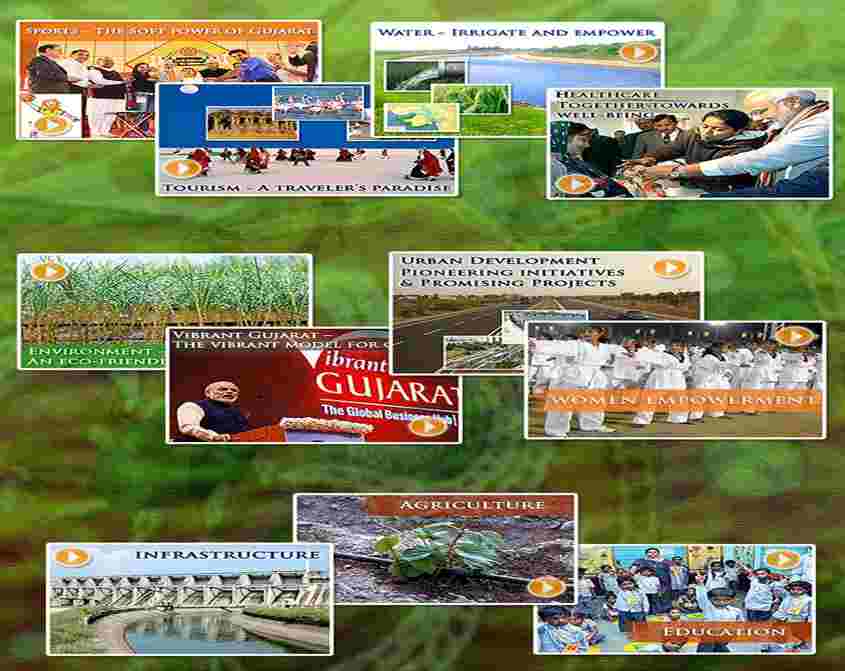
- Chief Minister Narendra Modi explains how this revolutionary transformation happened over a decade. In 2001 Gujarat was considered a drought-prone state… How did Gujarat manage a turnaround and achieve 11% agricultural growth in 2011?
How did Gujarat increase the agricultural land and cultivated area despite its fast-track industrial development?
What is “Apno Taluko- Vibrant Taluko” (ATVT)?
How did the fruits of development reach the poor and marginalized?
- Narendra Modi’s government is entering its 11th year. On this occasion in a tête-à-tête with the Chief Minister of Gujarat let us try to understand Gujarat’s march towards progress in the field of agriculture, infrastructural facilities like drinking water, education, employment, transportation, and tourism. Let us begin with agriculture.
- Narendrabhai, how much truth is there in the statement that the Gujarat farmer is marching financially ahead compared to his counterparts from other states?
CM: To bring happiness to the farming community the state government launched a campaign for agriculture development and water conservation to take the fruits of progress to village after village. The state government boosted agriculture growth by adopting scientific farming and cattle-rearing initiatives. Even nature has been kind in bestowing bountiful rains and the state has seen no drought in the last 10 years. Ten years ago, Gujarat farmers’ agriculture income was Rs 14,000 crore, which has risen to Rs 80,000 crore today. The average agricultural growth rate of the country is less than 3 percent while Gujarat’s has crossed the double-digit figure of nearly 11 percent. He is using drip irrigation, greenhouse, net house, and sprinkler techniques to maximize profit with minimum investment. Due to the soil health card, the productivity of the land has multiplied giving new directions to the agriculture sector.
- You say that the soil health card has multiplied the productivity of Gujarat farmers. Can you explain?
CM: Gujarat farmer has taken up modern methods of scientific farming leaving behind his old traditional approach. Soil health card has turned out to be a boon to the farmers as it helps educate them on deficiencies relating to the land and to what needs to be done to rectify these deficiencies. This has also resulted in the judicious use of fertilizers based on findings of the soil health checkup. Earlier there was a tendency to overuse fertilizers which invariably harmed the composition of the land. This harmful effect has been reversed and thereby has helped to save unnecessary expenditure on fertilizers. Considering this, the state government has decided to give soil health cards to every farmer in the state. Till now the lands of 42 lakh farmers have been tested and Gujarat is the first state to achieve this enviable record. Till March 2011, 31 lakh soil health cards have been disbursed, which is a record.
- There is also a school of thought that with industrial growth the cultivable land decreases. What is the status of Gujarat in this regard?
CM: You are right. Agriculture land holdings decrease when industrial development takes place. But Gujarat has turned out to be an exception as both industrial growth and agricultural land have increased. This is not a small achievement. The reason is the land which has been lying fallow for several years in the past is now getting water for irrigation and has become fit for farming. This achievement is also due to efficient and effective water management. The world and the country have taken note of this. I feel proud to say that the country’s apex court has recently lauded Gujarat’s land policy
- Narendra Bhai, achieving agriculture growth parallel with industrial growth is considered difficult. What is the condition of industries in Gujarat?
CM: What you say is correct. Strategic planning is undoubtedly needed to bring about agricultural and industrial growth parallel to each other. Gujarat organized five Vibrant Summits in the last decade and placed the state on the world map. If I can refer to the last summit of 2011, 7,936 MoUs were signed with an investment commitment of Rs 20.83 lakh crore. You must also realize that such a big investment would create over 52 lakh local jobs. In addition to this, it would also result in employment opportunities for the local youth. In agro-based industries, MoUs worth Rs 81,600 crores have been signed. We saw the dream of parallel development of agriculture and industry a decade ago. And today in 2011 it has become a reality and is a talking point world over. That is why I say that Gujarat dreams, Gujarat delivers.
- Vibrant Summit is good for big industries. What about small and medium-scale industries?
CM: This is a big misconception. On one hand, Gujarat is rearing to become the auto hub of India while on the other hand, it has also become the textile and petro capital. And for the growth of small-scale industries, we have a farsighted vision. The country’s 5 percent population lives in Gujarat which has 6 percent of the country’s land mass, and its GDP share is 10 percent. In this the contribution of nearly 4 lakh small and medium industries is noteworthy. The country’s 70 percent salt production is in Gujarat and the state also leads in caustic soda production (90%); chemicals (60%); petrochemicals (50%); pharma (40%); and polished diamonds (80%). Salt, pharma, and chemicals are largely run by small-scale entrepreneurs and are a large contributor to national growth. In the recent Vibrant Summit along with the development of small & medium enterprises, we had also thought of social sector development which surprised the world and the country.
- When you talk of industrial development how does it fit with social sector development?
CM: Obviously this is a question that arises in everyone’s mind. Let me say that in the last Vibrant Summit we particularly focused on the financial upliftment of rural poor to make them self-sufficient through a program called Mission Mangalam. In Mission Mangalam, not only the State Government but reputed corporate houses also will make joint efforts. The strength of Gujarat lies in its 50 percent population comprising women. If women are included in the path of progress, then the pace of development will be faster and more widespread. I am committed to adding the strength of Nari Shakti as a partner to development and decision-making. For this, I wished to extend economic activity support to women and created Sakhi mandals throughout Gujarat. Mission Mangalam is one such enterprise that helps the poorest of the poor women. Whether it is celebrating a marriage or tending to the sickness of her son or daughter, she need not depend on any external help. Lakhs of Sakhi mandals have been integrated with banks leaving the management of over Rs 1000 crore in their hands. It is our desire to take this amount to Rs 5,000 crore. Just imagine if this huge amount is managed by poor women, how much progress they would have really achieved!
- Narendrabhai when we are talking about the social sector and upliftment of the poor a question that arises is have you made any special efforts to see that benefits reach the concerned beneficiaries?
CM: You have raised a fundamental point…. The beneficial schemes if it remains on paper without reaching the targeted beneficiaries then it is useless. We decentralized the state’s administrative power through a milestone yojana to extend the benefits to the right people concerned. We recognize it as Aapno Taluko, Vibrant Taluko (ATVT). This is the Gujarat government’s efforts to reach the remotest areas of the state and bring the government to their doorstep. Jan Seva Kendras equipped with computers has been set up in every taluka with GSWAN connectivity. Different kinds of applications numbering 129 are accepted at these kendras. This revolutionary experiment is being implemented by District Collectors and a team of newly appointed pranth officers. I want to create a healthy competition of people’s participation among the Talukas in the State.
- You talk of ATVT but in practice do the benefits of government schemes reach the urban poor?
CM: Look, every solution to a problem is unique. Therefore, it needs farsightedness and political will. A concrete plan has been visualized for providing homes to the urban poor under the Garib Samriddhi Yojana. Gujarat is the only state in the country that has provided housing plots to all the BPL families which come within the 0-16 parameter. A sum of Rs 13,000 crore funds has been established for the welfare of the urban poor. Under Ummed program about two lakh youths have registered themselves and one lakh youth will be given skill development training for generating employment opportunities within one year.
- Chief Minister, employment and education are the two sides of the same coin. What is the status of education in Gujarat?
CM: I agree that employment and education go hand in hand. In the last decade, the government has done a lot to bring children within the ambit of primary education and access the fruits of development. If I talk of Shala Praveshotsav, I and my Cabinet ministers every year take part in it. We are taking care that the kids are enrolled at schools and continue with their studies whether they belong to rural or urban areas. Not only this, from Chief Secretary to all other secretaries take part in this novel cause by coming out of their AC chambers into the scorching 45 degrees of summer heat and touring villages. Can anything be more surprising than this? I don’t remember any government in the world where the chief minister and his cabinet and senior officials would take part in such a program. The government provides free textbooks and notebooks. And the outcome is there for all of you to see. It is a matter of pride that the dropout rate in Gujarat has drastically come down in the last decade. From Class I to V dropout ratio has fallen from 20.93 percent to 2.09 percent. While in Class I to VII dropout ratio is down from 39 percent to 7.45 percent.
- In helping youths access higher education what steps have been taken by the Gujarat government?
CM: In the past decade there has been a serious effort in helping the youth to access the portal of higher education which has never happened before. In 2001 we had only 11 universities. Today, there are 39 universities in Gujarat. The state government opened many new world-class universities towards training youth. It is not just opening new universities that are important but specialized world-class universities such as Petroleum University, Sports University, Raksha Shakti University, and Forensic Science University have also been set up here. To meet the present-day needs, about 52 colleges have been started with new courses. In the tribal belt, there are 35 colleges now functioning. For the first time in the country, a Children’s University has been set up and a Commission for Education Innovation had been started. A Gujarat Knowledge Society to has been set up to provide employment opportunities to the youth of Gujarat.
- What has the government done for the welfare of Adivasis?
CM: First and foremost, the Adivasis are our own brothers. They are part of the family of six crore Gujaratis. In Gujarat, the entire eastern belt from Ambaji to Umergaon comprises of Tribal population. To enable this tribal population of 75 lakhs, an innovative program “Vanbandu Kalyan Yojana” has been launched and for the first time in the history of Gujarat, a huge sum of Rs.15,000 crores has been allotted to bring them into the mainstream. This comprehensive development program aims at empowering through education and social initiatives. It has created awareness among them for an improved standard of life. Only four years have been completed since the launch of the scheme, and a sum of Rs. 17,000 crores has already been spent against Rs. 15,000 crores planned for five years. At the end of five years, more than Rs. 20,000 crores will be spent in development schemes making a change in the life of Adivasis. There is no parallel scheme in the entire country to compare with this all-inclusive initiative. Gujarat has shown the way to the entire nation by implementing a scheme that is acceptable and appreciated by all.
“I want to make one thing very clear. In the ten years of our journey of development, Gujarat has emerged successful in many areas through numerous initiatives. But without the blessings of six crores of Gujaratis, it would not have been possible to achieve this feat. This is the outcome of the determination of six crores Gujaratis for the development and commitment of six lakh fellow Karmayogis of my government, and the spirit of “Team Gujarat”. I thank the people of Gujarat and all the employees of the State Government on this occasion from the bottom of my heart.”
Growth Of Gujarat In Different Sectors
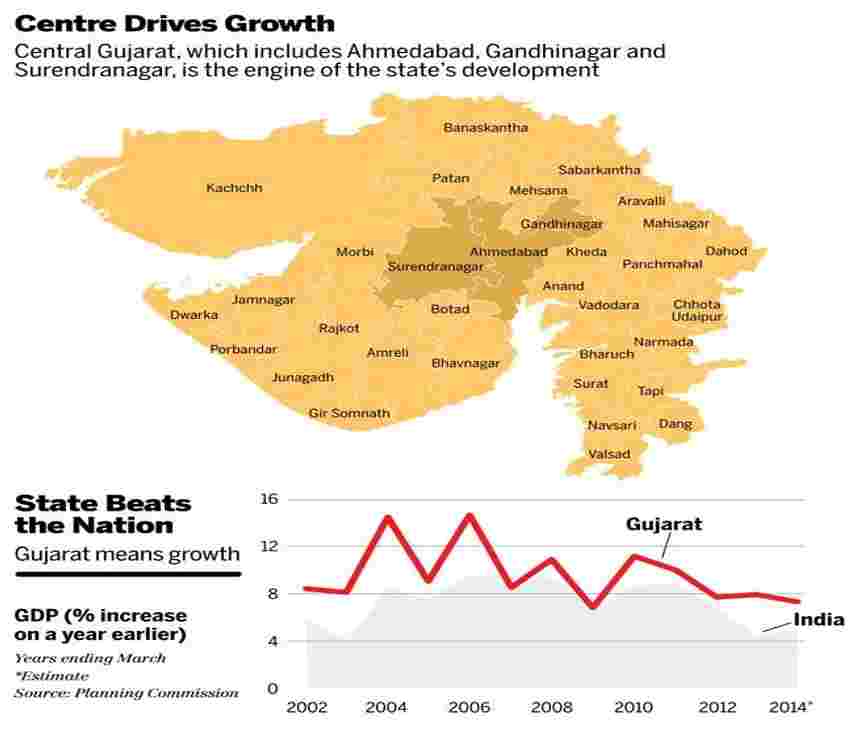
The growth story of Gujarat is one of a state punching above its weight. With only 6 percent of India’s land mass and barely 5 percent of its population, Gujarat has managed to account for 7.6 percent of the country’s GDP and 22 percent of its exports. Its annual Gross State Domestic Product (GSDP) growth from 2001 to 2013 (growth has slowed down since) averaged nearly 10 percent, which is faster than India’s. This is an extraordinary accomplishment. Between 1980 and 2013, Gujarat grew at an average rate of 5.1 percent. If Gujarat were a country with a 10 million-plus population, this would be the third-fastest growth rate in the world, after China and South Korea.
What were the factors that helped Gujarat accomplish this extraordinary growth? Was it geography, native entrepreneurship, a historical edge in commerce and trade, or simply good governance? The reasons for Gujarat’s growth can be debated. Did the fact that Gujarat has the longest coastline-1,600 km contribute to its rapid growth? Gujarat has served as an integral native trading hub for centuries, one of the most dominant in the Arabian Sea. After all, in India, most coastal states have shown higher growth than the BIMARU (an acronym for Bihar, Madhya Pradesh, Rajasthan, and UP, referring to their poor economic standing) states. A coastal state has the twin advantages of greater global access as well as lower transportation costs. Other coastal states, such as Maharashtra, Tamil Nadu, and Kerala, have also performed well. But sustaining rapid growth, as Gujarat has done, is not easy. Almost 25 percent of India’s sea cargo passes through Gujarat’s ports.
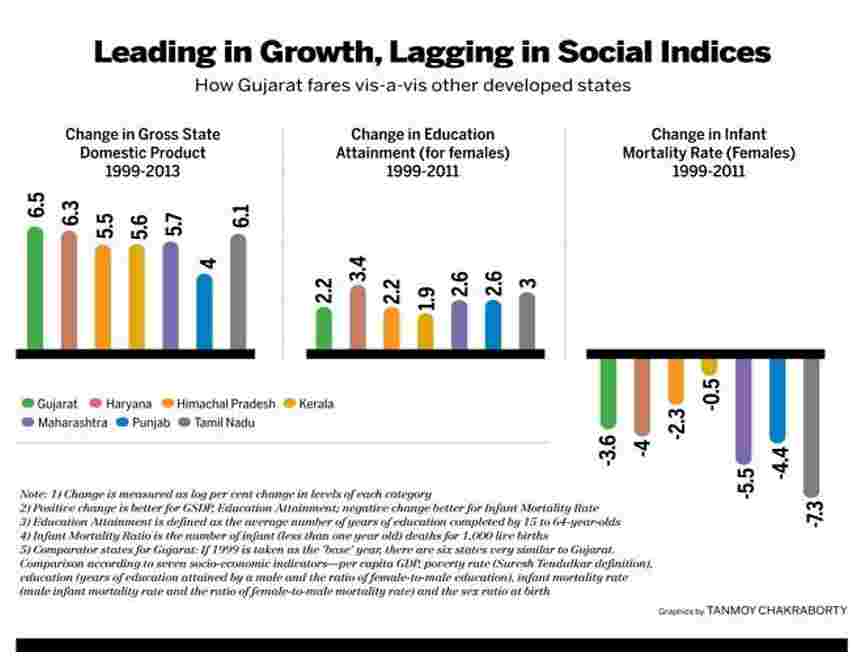
Was it the renowned Gujarati entrepreneurial spirit that helped bring about Gujarat’s transformation from being only the seventh richest big state in 1980-81 (in terms of per capita GSDP) to the third richest in 2013-14? Gujaratis have dominated businesses all over India for centuries. The Indian diaspora is dominated by Gujarati businessmen. Or was it good governance under successive regimes in Gujarat that brought about such development?
Gujarat has been among the fastest-growing states even in the past. Despite poor rainfall, it has made strides in agriculture. Unlike Punjab and Haryana, states which launched the first Green Revolution with government support, Gujarat’s agricultural transformation came via the market route. Cash crops such as cotton, oilseeds, and tobacco dominated the farm growth story. A milk revolution and large-scale exports of fish accompanied the growth in horticulture and a sharp increase in agricultural productivity. The agricultural turnaround-with growth rates as high as 11.1 percent between 2000 and 2013-was accomplished despite water scarcity. Gujarat knows the art of turning every calamity and tragedy into an opportunity. Despite the plague in Surat and the earthquake in Kachchh, the state’s economic growth rate has surged in the last one-and-a-half decades. The good governance story of Gujarat, however, takes a knock when it comes to inclusive growth and social sector development. Gujarat is a ‘model state’ in economic growth but a ‘middle state’ in social sector growth. Both agricultural and manufacturing growth is in double digits, but of the 20 major states in India, Gujarat’s ranking is always between 9 and 12 on all major social sector rankings. This is irrespective of how the measurements are done. Education, health, and other social sectors have grown much more conservatively. The challenge for the leaders in Gujarat is finding ways to bring about inclusive growth, alongside the remarkable growth rate.
1. State Of The State Report:-
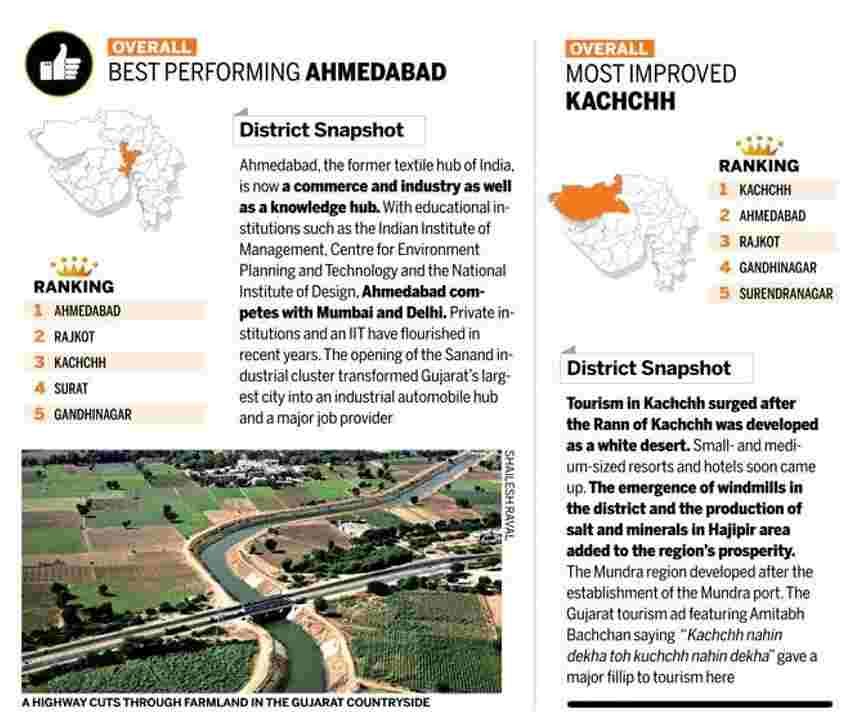
- With a firm belief that the future of the country lies in its states and Union territories, the State of the State (SoS) survey, started in 2003, emerged as the gold standard for analyzing the performance of states. The State of the State report was the next logical step. It analyses the performance of districts in each state over a period, and across various categories. Each category is usually a composite index of a few parameters, which are measurable across time, provided data is available. In the case of Gujarat, ideally one should compare all 33 districts. Seven of these districts were created in 2013, and eight were created over the period 1997 to 2010. Data for the recent seven is not available. For the eight districts created earlier, data is available sporadically. Thus, the district analysis presented in this report is for the 18 ‘original’ districts.
2. Gujarat Versus Six States:-
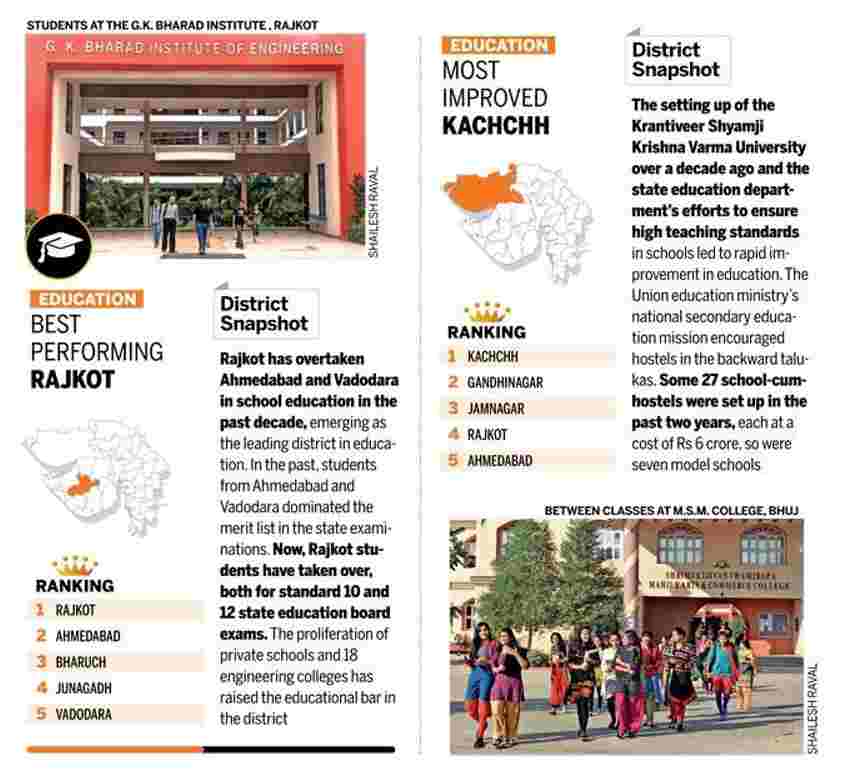
How well has Gujarat performed in terms of GSDP growth, education, health, and in other key categories can be best assessed by comparing its performance with that of other states; in particular, states closest to it in terms of socio-economic development. If 1999-2000 is taken as the ‘base’ year, it is found that across a wide array of indicators, Gujarat is closest to these six states-Haryana, Himachal Pradesh, Kerala, Maharashtra, Punjab, and Tamil Nadu. Three of them are coastal states, like Gujarat. These states will be referred to as C7 (comparable seven). Performance is measured in terms of various indicators of improvement (e.g., growth) over the period of 1999 to the latest year for which there is data-generally 2011 (the latest year for National Sample Survey, NSS, data on education) and 2013 (the latest year for GSDP).
Per capita GSDP growth: This is where Gujarat has excelled. The analysis of GSDP performance is conducted over two time periods- 1980-1999 and 2000-2013, for which there is data. The intention behind the comparison between the two time periods is to analytically separate the influence of history from good governance in later years. If per capita GSDP is the criterion, Gujarat was the seventh richest big state in India in 1980-81, fifth richest in 1999-2000, and third richest in 2013-14.
In per capita growth, Gujarat was the third-fastest growing state among C7. The fastest growing state was Maharashtra (4.3 percent), followed closely by Tamil Nadu (4.1 percent) and Gujarat (4 percent). Despite being a relatively rich state, Gujarat pushed itself into becoming the second-fastest growing state from the period 2000-2013 (average of 6.5 percent annually). The fastest growing state was Uttarakhand (9.2 percent), a relatively smaller and newer state.
Inequality: Was growth accompanied by growing inequality in the C7 states? Yes. Six of these states witnessed a rise in inequality (measured by the Gini index, which assigns a value of zero if everyone has equal income and a value of 1 if one person has all the income). Only one state, Tamil Nadu, witnessed a decline (-0.3 percent annual decline for the 12 years from 1999 to 2011, according to NSS data). Gujarat was the third-best performer, with an annual Gini increase of 0.7 percent.
Education: Gujarat hasn’t performed well here. NSS data on educational achievement (highest class attainment) is a much better index of educational attainment than provided by the literacy variable. Literacy tells whether a person is literate; educational attainment offers a measure of educational achievement.
In 1999-2000, Gujarat had about the same educational level (average educational achievement of 5.3 years) as Haryana, Punjab, and Tamil Nadu. In 2011-12, the state improved its average education level to 6.3 years; however, this improvement was the second worst, behind Kerala. It should be emphasized that Kerala had the highest education level in 1999-2000 (7.4 years) and maintained its highest education level position in 2011-12 (8.8 years). As with income, there is a catch-up phenomenon with education (and health), i.e., higher attainment states tend to improve at a lower rate. Hence, that Kerala improved its educational attainment at a rate of 1.4 years per annum is not a surprise; that Gujarat’s rate of growth in education was only 1.5 percent per annum is a big, negative surprise.
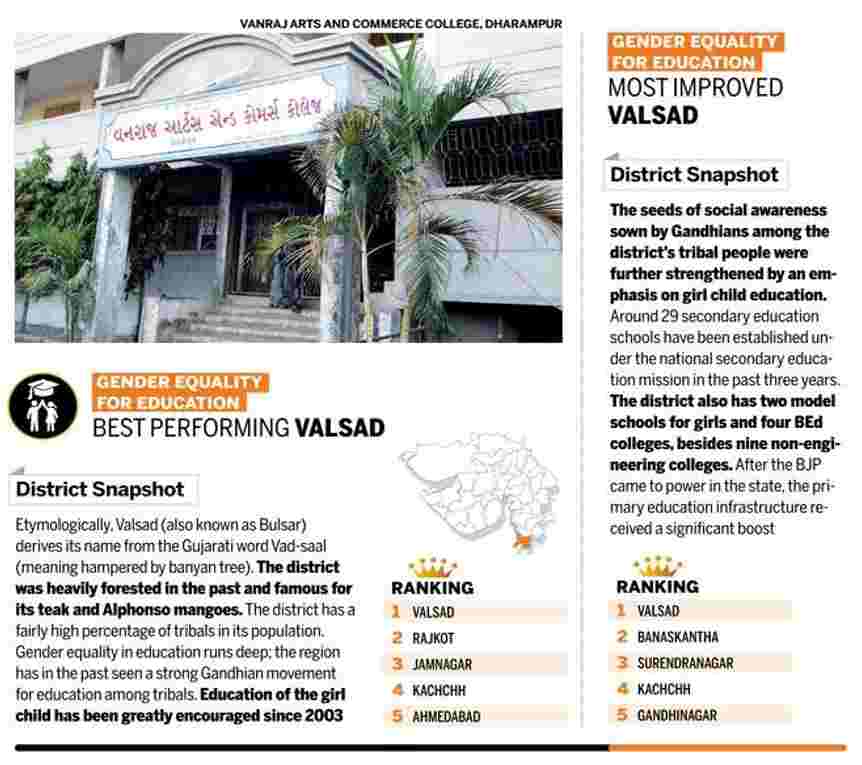
- Health: If measured by improvement in (the lowering of) the infant mortality rate (IMR), Gujarat does better in health than education-a decline in IMR by 3.6 percent per annum, identical to Haryana’s achievement. Kerala has the lowest rate of improvement (a decline of only 1.3 percent per annum, from 14 deaths per 1,000 births in 1999 to 12 deaths in 2011). Himachal Pradesh, too, has a low average rate of decline (IMR fell from 54 to 38 deaths per 1,000 births or by 2.9 percent per annum).
3. Regional Analysis Of Gujarat:-
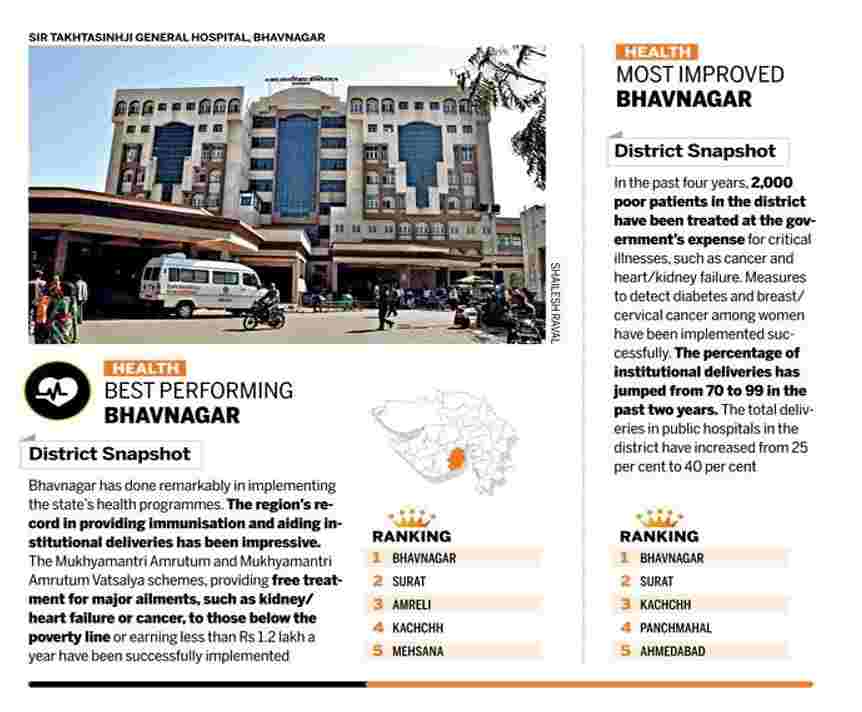
Gujarat was formed in May 1960 with 17 districts. Over the next six years, two more districts were added, one of which became the state’s capital. Another 14 districts were formed from 1997 to 2013. Consistent data for all variables are only available for the initially created 17 districts and for most variables for 18 districts. The analysis is done at the district level, taking these 18 districts as individual units, and at a regional level by classifying them into groups as described below. For ease of analysis, the entire state has been divided into three broad regions: Western Gujarat, Central Gujarat, and the Eastern Corridor. The demarcation is done based on income and poverty levels in 1999, weighted by the population of each district. Such an exercise shows Central Gujarat as the most prosperous, followed by Western Gujarat and the Eastern Corridor (see graphic: Centre Drives Growth). Any regional data provided is computed as a simple average of all the districts in the region.
Overall income: Since overall income comprises three categories-real wages, per capita household consumption, and absolute level of poverty-we look at all of these individually. The most prosperous area, Central Gujarat, has shown maximum improvement in a wages-an increase from an average wage of Rs 136.7 (2011-12 prices) to Rs 200.9 in 2011-as well as per capita household consumption. In terms of wages, Central Gujarat was followed by the Eastern Corridor (Rs 124.1 in 1999 to Rs 163.4 in 2011) and then Western Gujarat. Western Gujarat, which used to be the best in wages in 1999-2000, shows maximum improvement in reducing absolute poverty (from average absolute poverty of 26.5 percent in 1999 to 9.5 percent in 2011). In consumption, Western Gujarat is most improved, followed by Central Gujarat, then the East.
Education: In education, Western Gujarat has shown the best improvement from 1999 to 2011, across all the variables for education: mean years in education completed by an average 15–64-year-old for overall, male-female as well as female-male ratios. While Central Gujarat ranks second followed by the Eastern Corridor, the latter beat the former in the improvement of female to male education, which could be attributed to the performance of one of the Eastern Corridor districts-Valsad. Valsad is the winner in the category of gender equality for education.

Health: Central Gujarat performs the best in lowering IMR, followed by the Eastern Corridor and Western Gujarat. In 1999, the Eastern Corridor showed the worst IMR, followed by Central Gujarat and Western Gujarat respectively. Central Gujarat improved from 58.4 to 39.4 over the period of 1999-2011 to overtake Western Gujarat. This clearly indicates improvement in healthcare in the region. The Eastern Corridor, too, has closely followed, from 59.5 to 41.8 IMR. One of the Eastern Corridor districts-Bhavnagar-has witnessed a significant drop in IMR.
Overall rank: Central Gujarat is the best in the level of development. It also shows the highest improvement among the three regions. The conclusion is based on achievements in income, health, and education. Western Gujarat and the Eastern Corridor take the second and third positions respectively.
Gender equality in education: There are three measures for educational achievement in 2011-years of education (male), years of education (female), and female education as a fraction of male education. The female-male education ratio captures gender equality. In India, educational discrimination against girls is rampant. But with programs such as Beti Bachao Beti Padao, there is a new consciousness about the education of the girl child. The closer the girl-to-boy education ratio is to 1, the district is that much closer to gender equality.
Valsad shows a level higher than 100 (equality in male-female education achievement levels) for 2011; this number is the highest in the country. The data was taken from NSS, which, for some districts, can have small sample sizes. However, even in 2009-10, Valsad had the highest gender equality in education in Gujarat, with a ratio of 95.5 percent. In 1999-2000, the education gender equality ratio was 72 in Valsad, i.e., girls had only 72 percent of the education of boys. So, no matter how the data is sliced (1999-2000 to 2011-12 or till 2009-10), Valsad shows the highest rate of increase in girl-child education compared to boys.
4. District-Level Performance:-
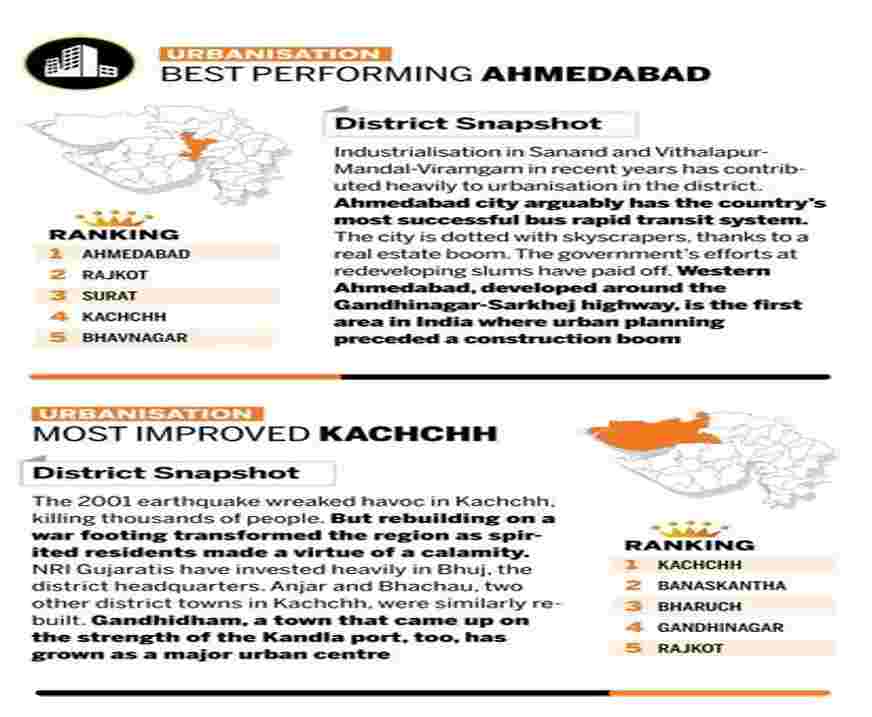
- This section will analyze performance in terms of levels, circa 2011, and the next section will look at performance as measured by changes (or growth) between 1999 and 2011. All rankings are based on the 18 districts for which consistent data are available: Ahmedabad, Amreli, Banaskantha, Bharuch, Bhavnagar, Gandhinagar, Jamnagar, Junagadh, Kachchh, Kheda, Mehsana, Panchmahal, Rajkot, Sabarkantha, Surat, Surendranagar, Vadodara, and Valsad.
5. Rankings By Level-2011:-
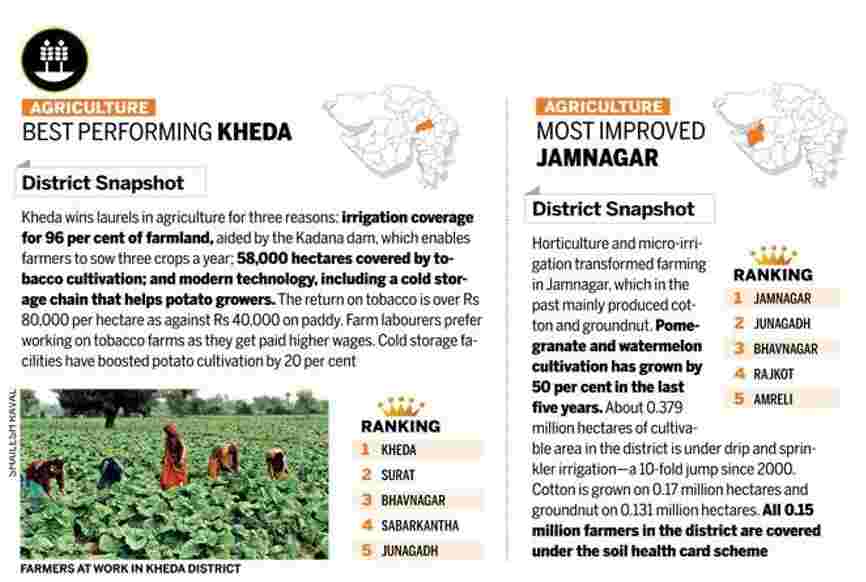
Income: In 2011, for the three income variables (real wages, real per capita income, and level of absolute poverty), Ahmedabad is the number one district. It has a score of 8 (the best score possible is 3, a rank of 1 in each category), followed by Kachchh (a score of 11). In third place is Rajkot with a score of 12.
Education: There are three measures for educational achievement in 2011-years of education (male), years of education (female), and female education as a fraction of male education. The best score is a sum of ranks of 3. For the first category, Gandhinagar ranks the highest. Ahmedabad ranks the highest for the second category of female years in education. Valsad ranks the highest in the third category. If we look at the overall education, incorporating all three, Ahmedabad holds the top position, followed by Rajkot and Bharuch. It is interesting that Ahmedabad and Rajkot are tied at an overall score of 8, and some distance behind is Bharuch. In the race for the best district, for income and education, Ahmedabad is in the lead.
Health: IMR is the major indicator of health in 2011. Bhavnagar has the lowest IMR of 8.3. This is followed by Surat at 11 and then, after a long gap, Amreli, Kachchh, and Mehsana at 27.5, 28.4, and 30.5 respectively.
Overall rank: The overall ranking is estimated as the sum of ranks for income, education, and health. The implicit weighting is that each category has one-third weight. However, as we have noted above, no matter what the weight, Ahmedabad is the unambiguous winner. The best (minimum) possible sum of the ranks is 7-3 (income) + 3 (education) + 1 (health). Ahmedabad scores 23. Next is Rajkot (28), then Kachchh (38).
Law and order: While there is data for various crime variables from 1999 to 2011, the ranking for crime is not included in our assessment for the best district. Nevertheless, an assessment of how each district has performed with respect to crime is relevant. Four indicators are combined to obtain an overall assessment. These variables (per hundred thousand of the population) are murder, attempt to murder, kidnapping, and rape. The best score obtainable is 4. The district with the least crime rate is Sabarkantha (score of 15), followed by Valsad, Junagadh, and Kheda at 18, 19, and 24 respectively. Bhavnagar has the fewest rapes per unit of population, followed by Panchmahal and Junagadh.
Conclusion
- Gujarat has shown it can achieve rapid growth for an extended period. From 1980 to 2013, the average per capita GSDP increased at a rate of 5.1 percent per annum. Gujarat could rank as the third fastest growing country in the world with a population of over 10 million. India ranks sixth currently. Gujarat’s record in education and health is not as good. Education improved at 2.2 percent per annum, about the same as India’s (2.1 percent). This would place Gujarat as ninth in the world. For Gujarat, the strategy should be to improve its education system, healthcare, and other social sectors on a war footing as these could become obstacles in its growth. The government must focus on the economic-social transformation of the Eastern Corridor and Western Gujarat. The state must uplift the tribal, Dalit, and minority communities from the remote, rural areas, who have been left out by the market-led growth. This will lead to inclusive development and reduce the inequality-the best recipe for growth.
Top 13 Facts About Gujarat Development Model
The 2015 Vibrant Gujarat summit, the seventh such event, will run for three days from January 11th, when Mr. Modi will make a speaking appearance. It will be a vast affair with visitors from 125 countries.
Gujarat is the only state in the country that has provided housing plots to all the BPL families which come within the 0-16 parameter.
A sum of Rs 13,000 crore funds has been established for the welfare of the urban poor.
Under Narendra Modi’s leadership, Gujarat was known for its development-oriented governance where the people were made active partners and stakeholders in the development journey.
The drought, cyclones, and floods in the preceding years too slowed the development journey.
Everyone thought the damage in Gujarat would take years to be undone.
Narendra Modi and his team proved everyone wrong by putting Gujarat on the path to recovery and development in a record time of under three years.
The strength of Gujarat lies in its 50 percent population comprising women.
Gujarat’s development journey is characterized as development-oriented, inclusive, and participative.
When Narendra Modi took over as the Chief Minister Gujarat was reeling under the effects of a devastating Earthquake.
On one hand, Gujarat is rearing to become the auto hub of India while on the other hand, it has also become the textile and petro capital.
Gujaratis have dominated businesses all over India for centuries.
“Van Bandhu Kalyan Yojana” has been launched and for the first time in the history of Gujarat, a huge sum of Rs.15,000 crores has been allotted to bring them into the mainstream.


